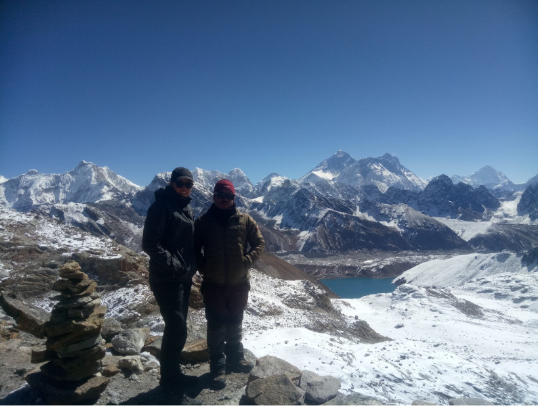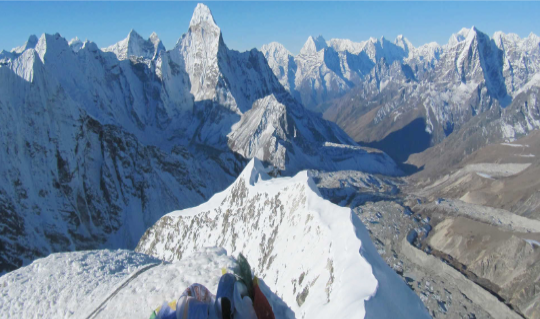Introduction
Island Peak Climbing (6,189 meters/20,305 feet) is one of the most popular trekking peaks in the Everest region of Nepal. It offers an adventurous climb suitable for those seeking to experience both the stunning views of the Himalayas and the thrill of peak climbing. Island Peak’s name comes from its resemblance to an island in a sea of ice, with its towering summit offering a unique perspective of the surrounding mountains, including Everest, Lhotse, and Makalu.
Key Information and Highlights
- Location: Sagarmatha National Park, Nepal
- Difficulty: Moderate to difficult (technical climb)
- Best Season: Pre-monsoon (March to May) and post-monsoon (September to November)
- Duration: Typically 18-20 days
Island Peak is ideal for climbers with some prior experience in trekking and mountaineering. The climb itself is challenging but manageable for those who are prepared. The journey also takes trekkers through some of the most iconic landscapes in Nepal, including the Sherpa villages of Dingboche and Chhukung.
Preparation Tips
- Physical training focusing on endurance, strength, and high-altitude acclimatization is crucial.
- Prior experience in trekking at high altitudes is highly recommended.
- A good understanding of technical climbing skills, including ice axe and crampon usage, is essential for the final summit push.
Itinerary and Highlights
The trek to Island Peak starts from Lukla and follows the classic Everest Base Camp route. Trekkers pass through Namche Bazaar, Tengboche, and Dingboche before reaching Chhukung, where they will begin the ascent of Island Peak. The climb involves a steep ascent, crossing glaciers, and using fixed ropes to summit.
Lobuche Peak Climbing
Introduction
Lobuche Peak Climbing (6,119 meters/20,075 feet) is another popular trekking peak located in the Everest region of Nepal. Known for its beautiful views of Mount Everest, Lhotse, and Makalu, Lobuche Peak offers a thrilling climb. While it is slightly less technical than Island Peak, it still presents significant challenges for climbers due to its steep ascent and high altitude.
Key Information and Highlights
- Location: Khumbu Region, Nepal
- Difficulty: Moderate to difficult (technical climb)
- Best Season: Spring (March to May) and Autumn (September to November)
- Duration: 16-18 days
Lobuche Peak is often climbed as part of the Everest Base Camp trek. The summit provides a panoramic view of the surrounding peaks, making it a sought-after destination for mountaineers looking for an accessible challenge.
Preparation Tips
- Prior experience with technical climbing and high-altitude trekking is required.
- Proper acclimatization to avoid altitude sickness is essential.
- Training in ice climbing, using crampons, and rope techniques is highly recommended.
Itinerary and Highlights
Climbers typically trek from Lukla to Everest Base Camp, passing through famous sites such as Namche Bazaar and Tengboche. After reaching Everest Base Camp, they continue to Lobuche, where they prepare for the ascent. The climb involves using fixed ropes to navigate steep sections, snow and ice fields, and technical rock face
Mera Peak Climbing
Introduction
Mera Peak Climbing (6,476 meters/21,246 feet) is the highest trekking peak in Nepal. It’s known for its less technical but demanding climb and spectacular views of the entire Everest region. The climb to Mera Peak is a popular choice for trekkers looking to experience mountaineering at high altitudes without the technical challenges of other major peaks.
Key Information and Highlights
- Location: Mahalangur Range, Nepal
- Difficulty: Moderate (non-technical climb)
- Best Season: Autumn (September-November) and Spring (March-May)
- Duration: 18-22 days
Mera Peak offers a less technical ascent, but it requires good physical conditioning, acclimatization, and the ability to handle high-altitude conditions. The views from the summit, which include Everest, Lhotse, Makalu, and Kangchenjunga, make the climb particularly rewarding.
Preparation Tips
- A good level of physical fitness is essential.
- Acclimatization and high-altitude trekking experience are recommended.
- Snow and ice climbing techniques may be necessary for the final ascent.
Itinerary and Highlights
The trek starts with a flight to Lukla and continues through the lush forests, Sherpa villages, and the traditional Himalayan landscapes to Mera Peak Base Camp. The final summit push involves a snow-and-ice climb, though it is relatively non-technical compared to other peaks.
Everest Three Passes Trek
Introduction
Everest Three Passes Trek is one of the most exhilarating and challenging treks in Nepal. This trek takes adventurers through some of the most remote areas of the Khumbu region, crossing three high-altitude passes—Kongma La, Cho La, and Renjo La. The trek provides trekkers with stunning views of the world’s highest peaks, including Mount Everest, Lhotse, and Makalu, while avoiding the crowds typically found along the Everest Base Camp route.

Key Information and Highlights
- Location: Everest region, Nepal
- Difficulty: Challenging (long and high-altitude trek)
- Best Season: Spring (March-May) and Autumn (September-November)
- Duration: 18-22 days
The Three Passes Trek offers a unique and off-the-beaten-path experience. It involves steep ascents, technical passes, and several days of trekking in high-altitude conditions. This trek is perfect for seasoned trekkers who want to experience more remote areas of the Everest region.
Preparation Tips
- Extensive high-altitude trekking experience is required.
- Acclimatization is critical to avoiding altitude sickness.
- A high level of physical fitness and stamina is necessary for this challenging trek.
Itinerary and Highlights
The trek begins from Lukla and includes days in Namche Bazaar, Dingboche, and Gorak Shep. The trek crosses each of the three passes—Kongma La, Cho La, and Renjo La—offering varying perspectives of Everest and other peaks.




